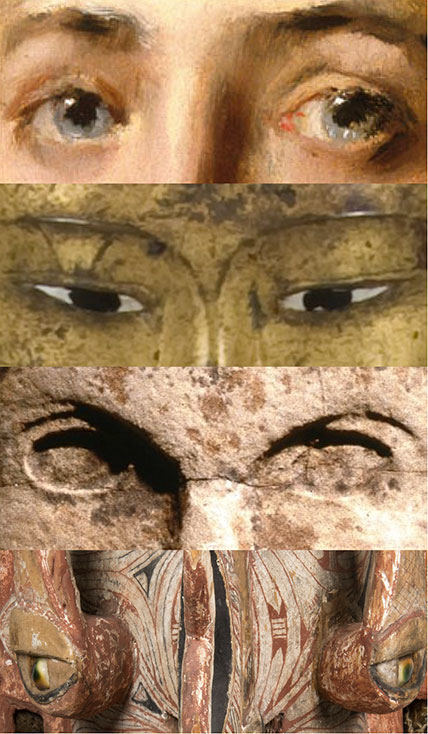
Details of four works in the Connecting Cultures installation, from top: Girl in a Japanese Costume, circa 1890, William Merritt Chase; Seated Shakyamuni Buddha, late 19th–early 20th century; Warrior Figure, Huastec, 13th or 14th Century; Mask (Ges), 19th century

Details of four works in the Connecting Cultures installation, from top: Girl in a Japanese Costume, circa 1890, William Merritt Chase; Seated Shakyamuni Buddha, late 19th–early 20th century; Warrior Figure, Huastec, 13th or 14th Century; Mask (Ges), 19th century
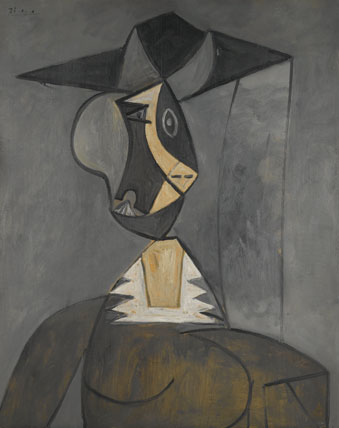
Woman in Gray, 1942. Pablo Picasso (Spanish, 1881–1973). Oil on canvas, 391⁄4 x 31 in. (99.7 × 81 cm). Brooklyn Museum; Gift of the Alex Hillman Family Foundation in memory and in honor of Rita K. Hillman, 2008.43
This is one of several paintings Pablo Picasso created in quick succession in Paris during World War II. In this fractured bust-length portrait of a woman wearing a veil and broad-brimmed hat, the artist’s abstractions evoke the violence and bleakness of life in the German-occupied French capital.
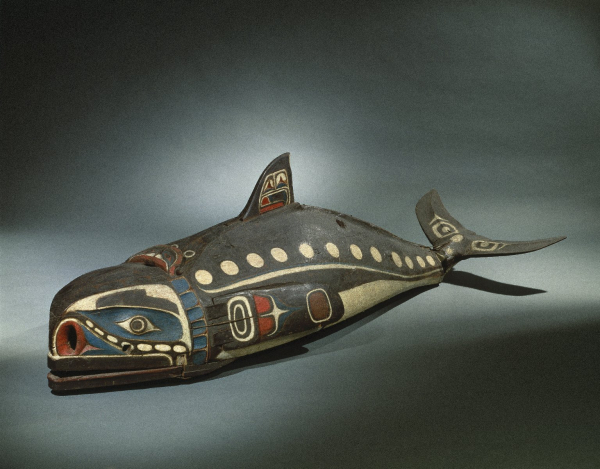
Baleen Whale Mask, 19th century. Unidentified Kwakwaka‘wakw artist. Victoria, Vancouver Island, British Columbia, Canada. Cedar wood, hide, cotton cord, nails, pigment, 235⁄8 x 281⁄2 x 811⁄8 in. (60 × 72.4 × 206 cm). Brooklyn Museum; Museum Expedition 1908, Museum Collection Fund, 08.491.8901
Masks like this are owned by a particular person who has inherited the rights to make, wear, and perform with it during potlatch ceremonies, elaborate communal celebrations. The mask is worn along the dancer’s back while he imitates the swimming and diving of the whale by manipulating cords to move the flippers, tail, and jaw. Others sing, shake rattles, and drum during the presentation. Such performances reaffirm and validate the owner’s rights to their clan’s history, honor their ancestors, and bring the mask to life.
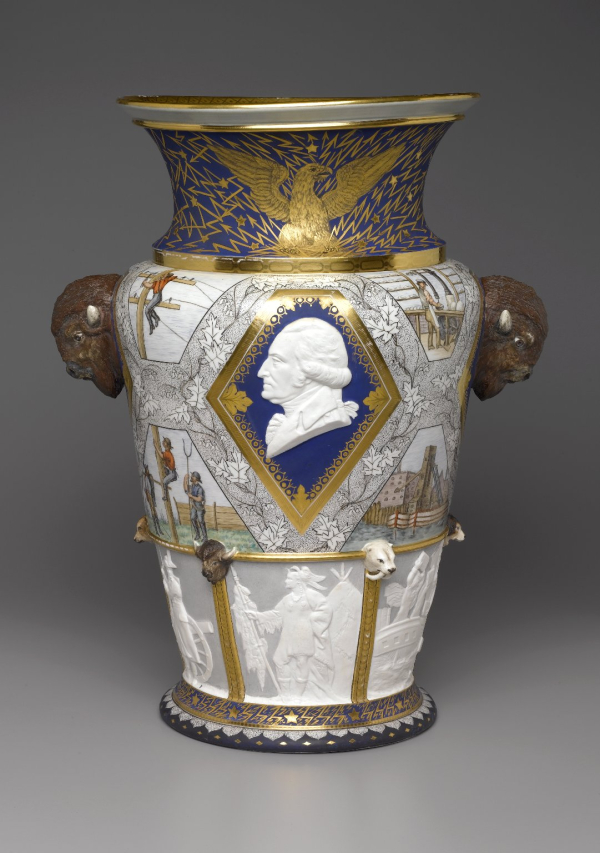
Century Vase, 1876. Designed by Karl L.H. Mueller. Manufactured by Union Porcelain Works. Greenpoint, now Brooklyn. Porcelain; height, 221⁄4 in. (56.5 cm); diameter of base, 10 in. (25.4 cm). Brooklyn Museum; Gift of Carll and Franklin Chace, in memory of their mother, Pastora Forest Smith Chace, daughter of Thomas Carll Smith, the founder of the Union Porcelain Works, 43.25
Created for the U.S. Centennial Exposition in Philadelphia in 1876, this impressive vase was designed by a German-born sculptor and made by a premier porcelain manufacturer. The symbolic images on this vase combine a sense of place with the sweep of history. Place is represented by depictions of native animals such as American bison, walrus, and rams. Scenes from the nation’s past and examples of American invention and progress, such as reapers, sewing machines, steamships, and telegraph poles, convey the sweep of history.
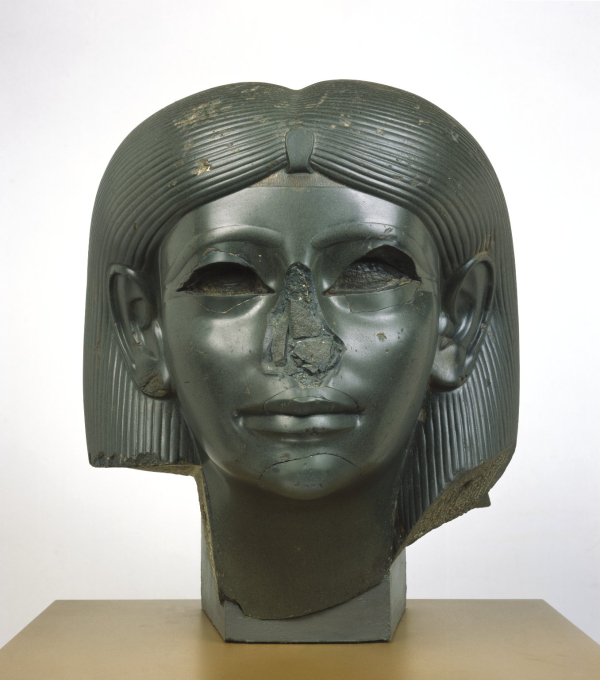
Head from a Female Sphinx, circa 1876–1842 B.C.E. Middle Kingdom, reign of Amenemhat II. Heliopolis, Egypt. Chlorite, 155⁄16 x 13 × 1315⁄16 in. (38.9 × 33.3 × 35.4 cm). Brooklyn Museum; Charles Edwin Wilbour Fund, 56.85
This head depicts an ancient Egyptian princess, daughter of King Amenemhat II, and originally had a lion’s body. Over the centuries, it has traveled from collection to collection, acquiring different meanings in each place.
The sphinx first served as a protective deity in a temple. It was brought to Italy, perhaps in ancient times, for sacred use in a temple of the Egyptian goddess Isis. In the eighteenth century, it represented typical Egyptian art in the collection of Cardinal Alessandro Albani. William Petty, second Earl of Shelburne, purchased it in 1772 to decorate his London house. A Sotheby’s clerk bought it for himself from a London antique shop in 1945. The Brooklyn Museum acquired it in 1956 as one of Egypt’s greatest masterworks.

Huastec. Warrior Figure, 13th or 14th century. Sandstone, 653⁄16 x 143⁄4 x 71⁄2 in. (165.6 × 37.5 × 19.1 cm). Brooklyn Museum, Frank L. Babbott Fund, 39.371
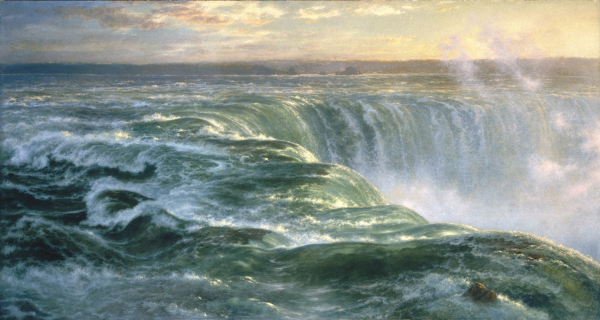
Niagara, 1866. Louis Rémy Mignot (American, 1831–1870).Oil on canvas, 483⁄4 x 911⁄2 in. (123.8 × 232.4 cm). Brooklyn Museum; Gift of Arthur S. Fairchild, 1993.118
Landscape imagery can make subtle reference to the prevailing politics of a place. From the eighteenth century on, Niagara Falls was among the most iconic symbols of American might and cultural potential. Its meaning shifts in this painting by Louis Rémy Mignot, a Southerner forced to abandon his rising New York career due to the outbreak of the Civil War. Mignot moved to London, where he painted this work the year after the war’s close. He pointedly chose an atypical view, facing the Canadian, rather than the American, side of the falls.

Doll’s House, 1952. Designed by Gerrit Th. Rietveld (Dutch, 1888–1964). Ameide, The Netherlands. Wood, metals, textiles, other materials, 24 × 36 × 24 in. (61 × 91.4 × 61 cm). Brooklyn Museum; Gift of Marcus S. Friedlander, by exchange, 2008.74
Like many toys, doll’s houses teach children how to live and behave in the adult world. In offering up the entire domestic world at a glance, doll’s houses also reflect, in particular, how objects surround human lives and exert their influence on us.
This doll’s house was designed by Gerrit Rietveld, one of the most important furniture designers, architects, and advocates of modernism in the early twentieth century. It was made for the children of the Jesse family, whom he was visiting at the time. Here, the children—Anita and Matcheld—could envision a pared-down lifestyle, surrounded by tasteful modern objects, in the postwar world.
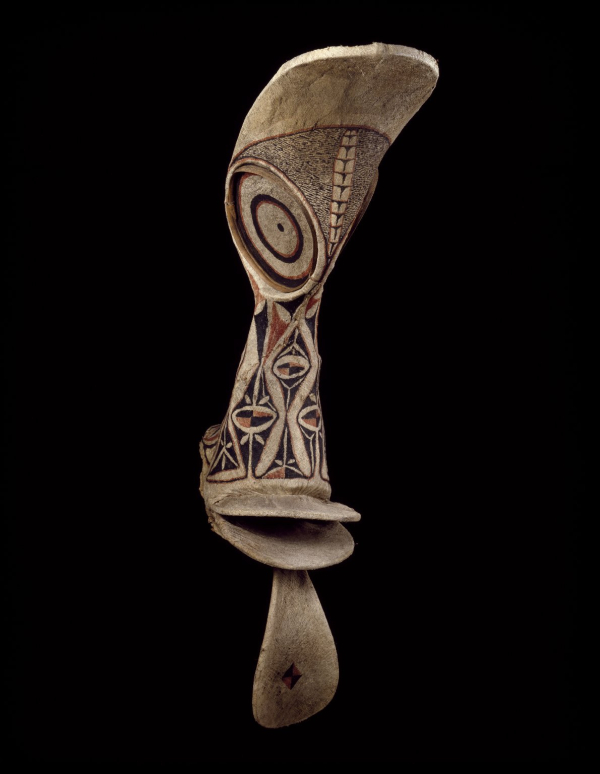
Kavat Mask, late 19th or early 20th century. Unidentified Central Baining (Uramot or Kairak subgroup) artist. Gazelle Peninsula, East New Britain Province, Papua New Guinea. Bark cloth, pigment, cane, 50 × 11 × 29 in. (127 × 27.9 × 73.7 cm). Brooklyn Museum; Gift of Thomas and Katherine Brush, 1994.142
Worn during spectacular night dances, this helmet mask represents a leaf spirit, one of the many bush spirits depicted by kavat bark-cloth masks. The mask is formed by stretching bark cloth over a thin cane frame. The pigments that decorate these masks have general symbolic associations: red with masculinity, reminiscent of the flames through which the mask dances at night; black with femininity, the soot of cooking fires, and fertile earth; and white with the spirit world.

Our Lady of Cocharcas Under the Baldachin, inscribed 1765. Unidentified artist of the Cuzco School. Cuzco, Peru. Oil on canvas, 781⁄4 x 561⁄2 in. (198.8 × 143.5 cm). Brooklyn Museum; Bequest of Mary T. Cockcroft, by exchange, 57.144
Long before the Spanish arrived in South America, the native Inca worshipped divinities at sacred sites. The Spanish brought Catholicism, and with it devotion to the Virgin Mary. The Church condoned the appearance of the apparition of the Virgin at ancient sacred places, such as Cocharcas, as part of its strategy of conversion.
This painting represents a pilgrimage to the Virgin of Cocharcas. Figures in both native and Spanish dress teem around the statue, which is under a canopy like the parasol carried over the head of Inca royalty. Both the place and the treatment of the human form express the continuity of religious devotion during a dramatic convergence of cultures.

Jacket from Man's Festival Costume, 18th century. Cotton, velvet, bark strips, metallic threads, and beads, 32 x 3 x 271/2 in. (81.3 x 7.6 x 69.9 cm). Brooklyn Museum, Museum Expedition 1941, Frank L. Babbott Fund, 41.1275.274a
Embroidered with gold and silver, this sumptuous festival jacket reflects the convergence of cultures in the Andes following the Spanish conquest of 1532. The costume, whose design is likely based on seventeenth-century Spanish court attire, is used to represent enslaved Africans who, along with indigenous people, labored in Bolivia's silver mines. The full costume is worn while performing the Morenada, or “dance of the blacks,” during community patron saint fiestas and urban Carnival celebrations. The indigenous tradition of masquerade in which many different ethnic groups are represented during festivals is prevalent throughout Latin America.

Cosmic Diagram, 18th century. Western India (Gujarat or Rajasthan). Opaque watercolors on cotton; sheet, 351⁄2 x 36 in. (90.2 × 91.4 cm). Brooklyn Museum; Brooklyn Museum Collection, X899.1
This image maps the cosmos as conceived by Jainism, an ancient Indian religion. In the Jain tradition, reaching Enlightenment requires a spiritual journey across levels of understanding. The levels are shown here as concentric rings separated by oceans. The world we know appears in the outer rings and in the corners, populated by people in small pavilions and crisscrossed by rivers. At the center is Jambhudvipa, the mountainous continent of the gods.
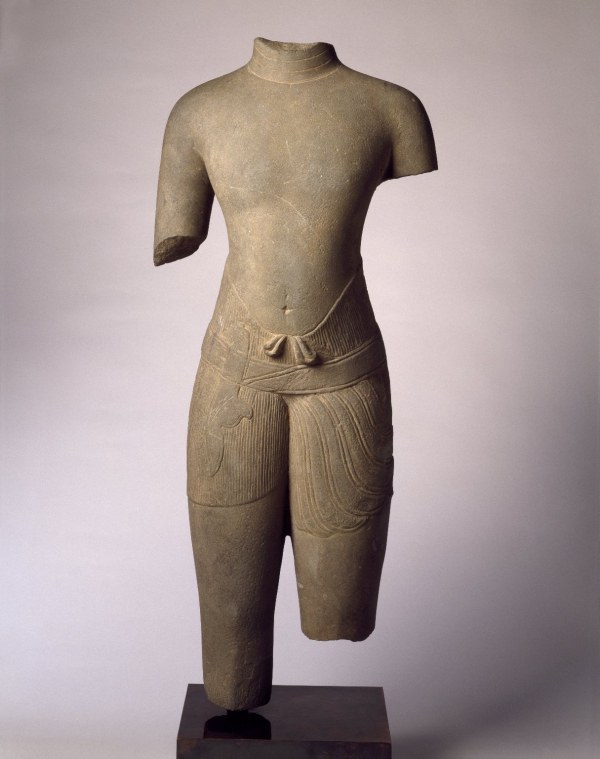
Torso of a Male Divinity, 1010–1080. Cambodia, Baphuon style. Sandstone, 301⁄2 x 121⁄4 x 53⁄4 in. (77.5 × 31.1 × 14.6 cm). Brooklyn Museum; Gift of Georgia and Michael de Havenon, 1996.210.1
The ancient kings of Cambodia were considered earthly manifestations of either Hindu or Buddhist deities, so icons enshrined in temples represented both god and king. Without its head or hands, the identity of this torso remains unclear, but the way that its wrapped skirt follows the contours of the waist indicates that it was carved under the patronage of Udayadityavarman II (reigned 1050–66), who was associated with the Hindu god Shiva.
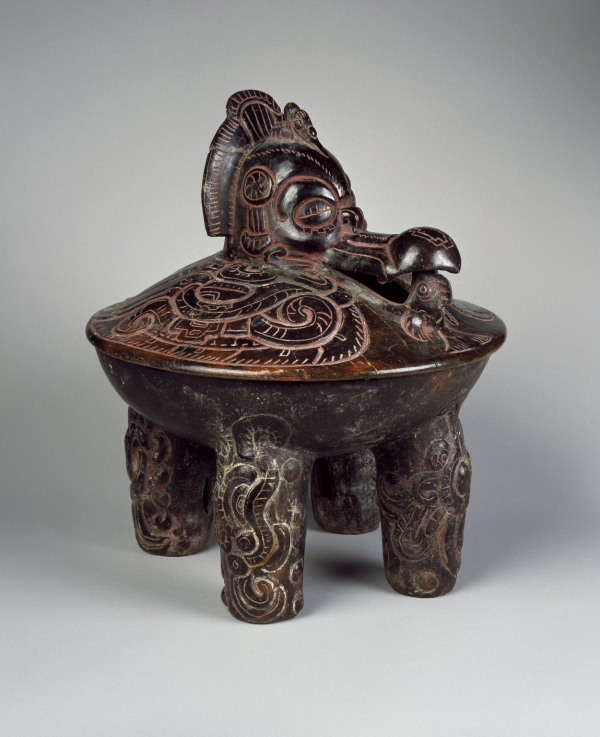
Tetrapod Vessel with Lid, 350–450. Unidentified Maya artist. Reported to have been found in Tabasco, Mexico. Ceramic, pigments, 61⁄4 x 101⁄2 x 101⁄2 in. (15.9 × 26.7 × 26.7 cm). Brooklyn Museum; Ella C. Woodward Memorial Fund, 64.217a-b
Ancient Maya art often refers to the structure of the universe, conceived as three vertical levels: the celestial upper world of supernatural beings and ancestors, the earthly middle world of human beings, and the watery underworld of the dead. The water bird on the lid of this vessel symbolizes the underworld, and the design on its beak signifies a portal to the supernatural realm. The four modeled legs of the vessel are four nose-down heads of peccaries (a type of pig), possibly representing the four pillars of the world, corresponding to the four cardinal directions.
Connecting Cultures: A World in Brooklyn
April 19, 2012–October 2, 2016
This innovative, cross-cultural installation was developed to create new ways of looking at art by making connections between cultures as well as objects. Located in our first-floor Great Hall, it provides for the first time a dynamic and welcoming introduction to our extensive collections, featuring pieces that represent peoples throughout time and around the world.
Connecting Cultures is organized around three main themes: “Connecting Places,” “Connecting People,” and “Connecting Things.” In viewing the juxtaposition of thematically linked works, you are invited to consider the importance of place, of self-representation in art, and of the role that objects play in supporting personal and cultural identity. Works on display include Gaston Lachaise’s monumental Standing Woman, Nick Cave’s Soundsuit, and kero cups used in Andean ritual.
Connecting Cultures: A World in Brooklyn was a joint effort of our curators, organized by Kevin Stayton, Chief Curator. The installation was designed by Matthew Yokobosky, Chief Designer, Brooklyn Museum.
Generous support for this long-term installation was provided by Lisa and Dick Cashin.